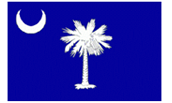Flags and Symbols of Confederate South Carolina
The Confederate Seal

The Confederate Seal was the seal of the government, styled Confederate States of America, of the eleven states that attempted secession during the War for Southern Independence.
The seal features George Washington on horseback, in the same position as a statue of him in Richmond, Virginia. Washington is surrounded by a wreath, which is made of some of the main agricultural products of the Confederate States, including wheat, corn, tobacco, and cotton. The margin of the seal features the words “The Confederate States of America: 22 February 1862” and the national motto, DeoVindice (“Under God, Our Vindicator” or “With God as [our] Champion”). The date on the seal represents when Jefferson Davis was inaugurated after the first and only Confederate general election and is also Washington’s birthday.
The Confederate Flag
This banner, the witness and inspiration of many victories, which was proudly borne on every field from Manassas to Appomattox, was conceived on the field of battle-lived on the field of battleand on the last fatal field ceased to have place or meaning in the world.
But the men who followed it, and the world which watched its proud advance or defiant stand, see in it still the unstained banner of a true and generous people, whose deeds have outlived their country, and whose final defeat but added luster to their grandest victories.
It was not the flag of the Confederacy, but simply the banner-the battle flag-of the Confederate soldier. As such it should not share the condemnation which our ’cause’ received, or suffer from its downfall. The whole world can unite in a chorus of praise to the gallantry of the men who followed where this banner led.”
from a speech by General P.G.T. Beauregard, C.S.
1st National Flag 1861-1863

The First Official Flag of the Confederacy. The ‘Stars and Bars’ was used as the official flag of the Confederacy from March 1861 to May of 1863. The pattern and colors of this flag did not distinguish it sharply from the Stars and Stripes of the Union.
This confusion was caused on the battlefield. The seven stars represent the original Confederate States; South Carolina (December 20, 1860), Mississippi (January 9, 1861), Florida (January 10,1861), Alabama (January 11, 1861), Georgia (January 19, 1861), Louisiana (January 26, 1861), and Texas (February 1, 1861).
2nd National Flag 1863 – 1865

The ‘Stainless Banner’ was adopted in 1863 by the provisional government of the Confederate State. The design change came because the 1st Nation was sometimes misidentified as the US Federal flag on the battlefield when it was hanging down a pole. This flag is sometimes referred to as the Stonewall Jackson Flag. This was the flag the draped General Jackson’s casket
3rd National Flag 1865-present

The 3rd National Flag would be the last official flag of the Confederate States of America. Also known as the ‘Final Edition’, the flag was modified from the 2nd National. The red bar was added to remove the resemblance of the flag of surrender from the 2nd National.
South Carolina Sovereignty Flag December 1860

The popular flag that was raised after the South Carolina Secession Convention voted to secede from the Union. The flag was used as inspiration in the designing of the Confederate battle flag.
Army of Northern Virginia Flag
“The Battle Flag” December 1861 – present

At the First Battle of Manassas, Gen P.G.T. Beauregard noticed the confusion due to similarities between the First National Flag and the US Flag. His troops had also brought their colors. This enhanced the confusion.
Beauregard called on his aide William Porcher Miles to design a flag that would be used for guiding the troops into battle. Miles drew inspiration from the South Carolina Sovereignty flag in the design of the flag that would become synonymous with the Confederacy. The flag would be used in battle for the first time in December 1861.
1st Confederate Naval Jack 1861-1863

The First Confederate Navy Jack consisted of a circle of seven 5-pointed white stars on a field of light blue.
Second Confederate Naval Jack
1863-present

The Second Confederate Naval Jack was an elongated version of the Confederate Battle Flag. The Naval Jack saw service by several Confederate Army units. Gen Braxton Bragg ordered the flag to be used by troops falling under his command within the Army of Tennessee.
Bonnie Blue Flag

The Bonnie Blue never gained recognition as a true secession flag. The flag gained prominence after Irish songwriter Harry Macarthy penned a song bearing the name. Macarthy wrote the song after seeing the same flag raised in Jackson, Mississippi following the state secession from the Union. The song, Bonny Blue Flag, became the second most patriotic song in the Confederacy. After the war, the flag was displayed outside houses to signify a safe house for traveling Confederate soldiers.
South Carolina State Flag
Adopted 26 Jan 1861

Following South Carolina’s secession from the union, discussions emerged on a flag to represent the new Republic. The Senate and House discussed many ideas. A joint committee agreed on the flag show. It was formally adopted on Jan 26, 1861.
South Carolina State Flag
Adopted 28 Jan 1861

Two days later, the flag was changed to make the palmetto tree white. No other flag change has been adopted since. in the 1900s, the historical commissioner for South Carolina changes the crescent to face in the direction that is synonymous with today’s South Carolina Flag.
Big Red

Big Red – The official flag of the Citadel. Is this the original flag depicted? The document Big Red: A Timeless Symbol of Duty, Honor, and Courage wrote by Lt Col Andrew D. Kullberg, USAF (Retired) Member, Citadel Historical Council The class of 1983 brings some very interesting facts. A fund has been setup to try and bring the flag home. Download the article here: Big Red